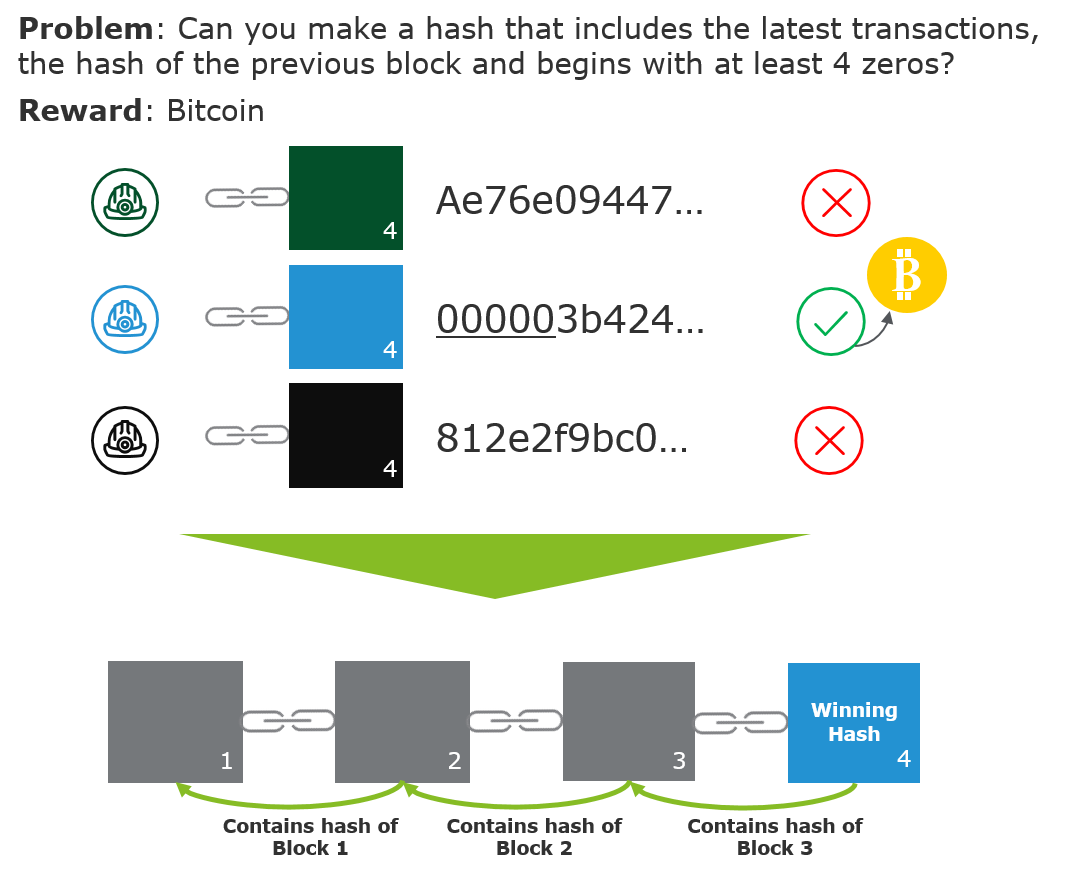This has got to be by far the most frequently asked question by other Leftists and it’s a good question to ask. It’s also not surprising considering we know from the IPCC report that we have until 2030 to decrease our carbon emissions by half and reach net-zero by 2050. Like many of you probably, I’ve also been suffering from climate anxiety caused by the constant onslaught of news about how it’s only getting worse and how little is being done by those in power (Can we please just take all the billionaires’ money already?). It’s not surprising that when as article published in Joule claimed that Bitcoin’s energy consumption was close to levels produced by Jordan and Sri Lanka, there was a serious amount of attention from the press. Why does this internet money thing use so much energy?

How Bitcoin Achieves Consensus
In order to understand where the energy use is coming from, we need to know a little bit about what’s going on under the hood (In case you haven’t, it might help to also read my article titled Blockchain 101: The Technical Stuff (Part 2)). Because blockchain is a peer-to-peer network trying to form one version of a database, it needs a way everyone in the network to agree with how they determine what is true or not. In Blockchain World this is called the consensus mechanism.
The consensus mechanism used in bitcoin is called Proof of Work (PoW). Under this mechanism, miners compete with each other to solve a very hard math problem that can only be solved through guessing. You heard me. Miners are essentially gambling by playing a game of statistics. How is this possible? Well it’s because it uses a neat trick using hashes.
A hash is the output of a hash function that has received a string of data as an input. A hash function is one-directional and its hash output is random and always the same size. If you look at the image below, you’ll see that it is impossible to tell what the input is of a hash output and the similar inputs create drastically different outputs.
In bitcoin’s PoW, miners are competing to create a hash starting with some number of zeros with the inputs of 1) all transactions recently sent to the network, 2) the hash created to make the previous block and 3) a random number called a nonce. Miners are incentivized to solve this problem because if they guess the right answer first they win newly created bitcoins (which also leads to some inflation). Winning miners are also given the transaction fees paid by people to get their transaction added to the new block of transactional data. This means the more you pay for a transaction, the sooner you are to get your transaction verified by a miner.

Don’t believe me? Try it out here.
On the surface, hashing is actually a pretty cool way to hide information, but in PoW, bitcoin makes the unholy alliance between hashing and free market competition. Since 1 and 2 are inputs that cannot be changed, the only way a miner can make new guesses is by changing 3, the nonce. This means that miners are also incentivized to use equipment (graphics cards) that is really good at doing one thing (guessing), really really fast. The faster you can guess, the more likely you are to create a hash with the appropriate amount of zeros in the beginning. This in turn creates an arms race for the fastest guessing machine and also for having a lot of them to increase your chances of making the right hash. On top of that, these machines use a lot of energy. See how free market competition is leading to an enormous waste of resources?

I can’t think of anything funny, I just think it helps sometimes to see things explained visually as well
“So ha! You just proved that blockchain is wasteful and doesn’t deserve our time!”
Hold up a second, let’s keep this in perspective. So yes, bitcoin uses a lot of energy and is pretty wasteful. A study done by Digiconomist found that in the past year, carbon emissions due to the upkeep of the bitcoin network was equal to 34.7 million tons. This is even higher than the claims made in the Joules journal. Now it’s at the same level of consumption as Denmark! But is this frame of thinking the most useful one to make? Bitcoin isn’t a country, it’s more like a part of an industry for making near real-time transactions between people through the internet without a central authority. Let take a look at other industries to compare.
The fashion industry generates 1.26 billion tons of greenhouse emissions (with a ‘b’ not an ‘m’ like in bitcoin) every year, which is more than the amount created by international flights and the shipping industry combined. This also represents about 8% of total global climate impacts. There’s also all the plastic microfibers that end up in the oceans and in our food. This is especially insidious because fashion brands are using greenwashing marketing techniques to sell even more clothes to well-meaning consumers by riding the wave of sustainability consciousness that has been picking up the last couple of years. Not to mention that the current existing financial industry invests billions in oil and gas projects and even in the face of tremendous evidence of human caused climate change, the World Bank still keeps investing in large fossil fuel projects.

They’re always going to choose to save the profits
So am I defending bitcoin? No. But I think it’s important to note that bitcoin’s Proof of Work (PoW) was the very first attempt at creating an algorithm for a decentralized cryptocurrency. And just like all technology, usually the first version of it is pretty clunky, but it works. The reason it uses so much energy is because of capitalism.
Miners think like businesses. They want to increase revenue through transaction fees and mining rewards while decreasing cost by paying as little as possible for electricity. This means that they are stuck in a feedback loop of buying stronger and more equipment but many of them set up shop in places where electricity is cheap. Places that have cheap electricity usually get it from renewable resources like hydroelectric or geothermal. Some people may argue that miners are helping grow the renewable energy market. However it is still true that bitcoin is wasteful in energy use because the PoW algorithm does not solve for anything useful.
PoW is not the only consensus mechanism out there. The second most popular consensus mechanism is Proof of Stake (PoS) which is a type of consensus mechanism that uses a small fraction of the total energy that PoW uses. Instead of competing for a reward, people can “stake” their crypto to increase their chances of becoming a block reward winner. I’ll go into more detail about the pros and cons of that one in a later article. There are also plenty of other ones out there as well that use substantially less energy as well.
Blockchain Projects for Climate Action
The Blockchain World is acutely aware that bitcoin’s energy use is wasteful and in general looks for alternative ways of setting up a blockchain that doesn’t use a lot of energy. Some projects even try to find ways that blockchain can fight against climate change. This isn’t to say that blockchain will “solve” climate change (only producing less emissions and restoring forests through a mass movement will do that) but there could be ways that it could help. Note that there are going to be blockchain projects that greenwash themselves, but I won’t mention those.
International organizations like the United Nations have discussed supporting blockchain based solutions to help with the climate crisis. Use cases include peer-to-peer trading of clean energy, carbon emission trading, and tracking of greenhouse gas emissions. Back in 2018, ClimateCoop won a UN Environment hosted competition titled “Synergistic Solutions for Sustainable Development.” ClimateCoop is a blockchain based platform for decentralized collaboration, governance, and community development for reaching Sustainable Development Goals (SDGs).
Computer programmer and author of Socialism and the Blockhain, Steve Huckle (@SteveHuckle) is developing a project called Enervator. It’s a cryptocurrency (EOR) built on top of Ethereum that incentivizes energy efficiency by using algorithms that pegs the value of the token to the inverse of global per capita energy use. This means that as energy use per capita decreases, the price of the token increases.
If you liked the article and want to be sure that you see more content like this, please sign up for the Newsletter, follow me on Twitter (@TBSocialist), and / or join the r/CryptoLeftists subreddit. Also if you have the means to do so, please consider donating to my Patreon so we can continue to give a voice for the Left in crypto.

